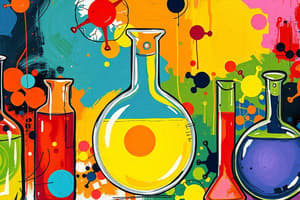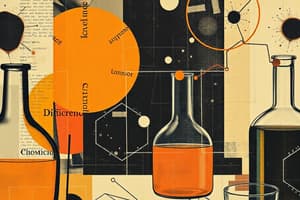Podcast
Questions and Answers
What is an element?
What is an element?
- A pure substance made of one kind of atom (correct)
- A mixture of different types of particles
- A collection of atoms with variable properties
- A compound formed by chemical bonds
An impure substance contains a mixture of two or more types of particles.
An impure substance contains a mixture of two or more types of particles.
True (A)
What is the smallest particle of an element called?
What is the smallest particle of an element called?
atom
The center of an atom is called the ______.
The center of an atom is called the ______.
Which of the following sub-atomic particles has a positive charge?
Which of the following sub-atomic particles has a positive charge?
Match the sub-atomic particles with their charges:
Match the sub-atomic particles with their charges:
Electrons revolve around the nucleus in defined paths known as shells.
Electrons revolve around the nucleus in defined paths known as shells.
A pure substance has _________ composition throughout.
A pure substance has _________ composition throughout.
Which of the following is NOT a noble gas?
Which of the following is NOT a noble gas?
All non-metals are brittle.
All non-metals are brittle.
Name an example of a metalloid.
Name an example of a metalloid.
The symbol for Iron is ____.
The symbol for Iron is ____.
Match the following elements with their classification:
Match the following elements with their classification:
Which property is characteristic of metals?
Which property is characteristic of metals?
All metals are solid at room temperature.
All metals are solid at room temperature.
What is a common use of noble gases?
What is a common use of noble gases?
____ and Neon are examples of noble gases.
____ and Neon are examples of noble gases.
Match the following non-metal characteristics with their definitions:
Match the following non-metal characteristics with their definitions:
Which compound has the formula H2O?
Which compound has the formula H2O?
Compounds can be separated into their constituent elements by physical methods.
Compounds can be separated into their constituent elements by physical methods.
What is the molecular formula of sulphuric acid?
What is the molecular formula of sulphuric acid?
The compound NaCl is commonly known as ______.
The compound NaCl is commonly known as ______.
Match the following compounds with their formulas:
Match the following compounds with their formulas:
What is the symbol for Tungsten?
What is the symbol for Tungsten?
The atomicity of most metals is two.
The atomicity of most metals is two.
What term describes the number of atoms that constitute a molecule?
What term describes the number of atoms that constitute a molecule?
Elements are made of only one kind of __________.
Elements are made of only one kind of __________.
Which of the following molecules has an atomicity of 4?
Which of the following molecules has an atomicity of 4?
Chlorine is a diatomic molecule.
Chlorine is a diatomic molecule.
Provide an example of a molecule of an element.
Provide an example of a molecule of an element.
The molecular formula for oxygen is __________.
The molecular formula for oxygen is __________.
Match the following elements with their atomicity:
Match the following elements with their atomicity:
Which of the following statements about elements is correct?
Which of the following statements about elements is correct?
Flashcards are hidden until you start studying
Study Notes
Elements
- An element is a pure substance composed of one kind of atom, unable to be broken down into simpler substances.
- Pure substances have uniform composition and defined properties; impure substances contain mixed particles and lack definite composition.
- Atoms are the smallest units of elements, examples include oxygen (O), hydrogen (H), nitrogen (N), and sulfur (S).
Structure of Atom
- The nucleus at the atom's core contains:
- Protons (+): Positively charged particles.
- Neutrons: Neutral particles with no charge.
- Electrons (-): Negatively charged particles, orbiting around the nucleus in shells.
Classification of Elements
- Elements are categorized as metals, non-metals, metalloids, and noble gases.
- Metalloids display properties of both metals and non-metals (e.g., Boron, Silicon, Germanium).
- Noble gases are inert and found in trace amounts in the air (e.g., Helium, Neon, Argon).
Metals vs. Non-Metals
- Metals possess lustre, are typically hard (except sodium and mercury), malleable, ductile, sonorous, and good conductors of heat and electricity.
- Non-metals lack lustre, are brittle, not malleable or ductile, do not resonate, and are poor conductors of heat and electricity (except graphite).
Element Names and Symbols
- Some element symbols are derived from Latin names:
- Iron: Ferrum (Fe)
- Tungsten: Wolfram (W)
Molecules
- A molecule represents the smallest particle of a substance that can exist independently.
- Molecules form from:
- The combination of the same elements (e.g., O2, H2).
- Different elements (e.g., HCl, H2O).
Atomicity
- Atomicity indicates the number of atoms in a molecule.
- Most metals and noble gases have an atomicity of one (monoatomic).
- Common molecular formulas and their atomicity include:
- Hydrogen (H2): atomicity 2
- Ozone (O3): atomicity 3
- Phosphorus (P4): atomicity 4
Compounds
- A compound is a pure substance formed from two or more different elements combined chemically in a fixed ratio.
- Examples of common compounds and their formulas:
- Water: H2O
- Ammonia: NH3
- Sodium Chloride: NaCl
Characteristics of Compounds
- Elements in a compound are chemically bonded in a specific ratio (e.g., water consists of two hydrogen atoms for every oxygen atom).
- Compounds exhibit unique properties distinct from their constituent elements.
- Elements within a compound cannot be separated by physical methods; separation often requires chemical reactions (e.g., electrolysis for water).
Studying That Suits You
Use AI to generate personalized quizzes and flashcards to suit your learning preferences.




